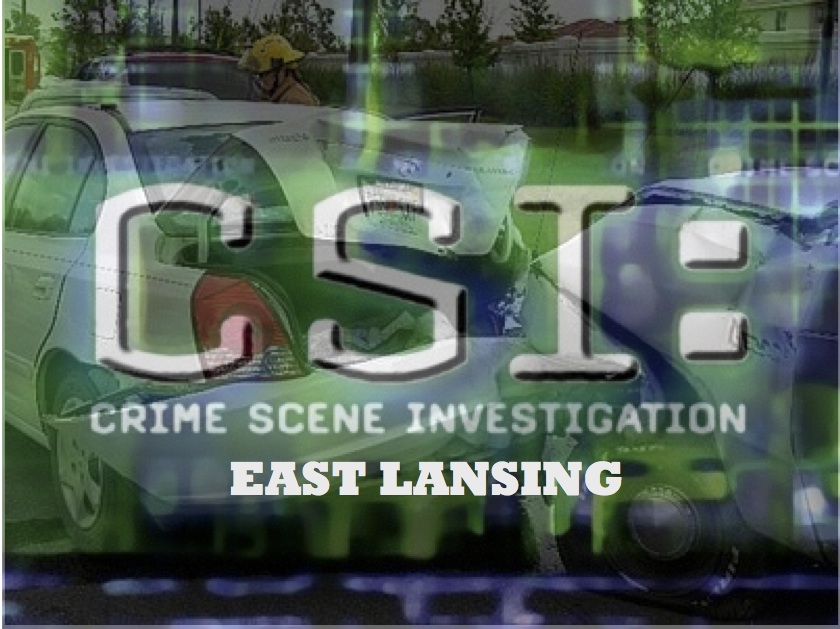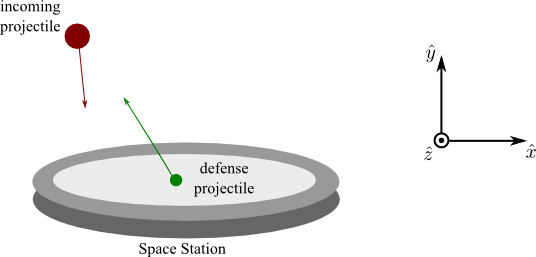Project 8: Part A: CSI East Lansing Part 1
You are a group of scientists who are a member of an elite crime scene investigation unit who focus on traffic accidents. You have been called to the scene of an accident between two cars. Your initial assessment allows you to come to the conclusion that one of the cars has obviously run into the back of the other. Your team finds brake marks on the road. After examining the scene of the accident you conclude that one of the cars, a Volkswagen New Beetle was parked with its handbrake on and only the driver in it before the accident, while the other car, an Audi tt had a single male occupant (33 years old) who crashed into the back of the Beetle. Both cars were empty except for their drivers. The point on the road where the impact took place is indicated and you notice brake marks leading up to the impact and brake marks after the impact. After the impact, the cars were stuck together. The accident took place in a 40 mph zone and the road was dry. It is your task to determine if the person driving the Audi was speeding. There is a technical expert at the scene of the accident who will make any measurements you ask for.
Project 8: Part C: CSI East Lansing Part 2
The Audi TT drivers lawyer feels as if they have come up with a foolproof scientific argument as to why their client was speeding. They indicate that the car was actually traveling up an incline of 8 degrees when it started breaking. You have been brought in as an expert witness to indicate whether this is true or not. As an expert witness, the court wants you to show that whether you solve the frictional parts of the problem with energy or momentum you still get the same result. If you solved the frictional parts of the problem with momentum in the first part then switch to energy and do the opposite if you did it the opposite way around.
Project 8: Part C: CSI East Lansing Part 4
Dear Sir/Madam:
I am writing you in regards to a court case pertaining to the evidence collected in the aforementioned accident. Both the prosecution and defense attorneys have filed briefs containing certain claims about the “physics of the incident” that are being used to suggest whether the accused was driving illegally. The claims suggest either that the accused was (1) speeding prior to locking his brakes or (2) traveling at the appropriate speed.
I include each claim below and ask that you identify if the claim is warranted (a simple ‘Yes, this is true’ or ‘No, this is untrue’ is fine) and to provide reasoning for your evaluation. I have numbered the claims to make it simpler to reference them.
- The victim's injuries are a result of the incredible force exerted on him compared to the smaller force he exerted on the accused's car. The greater force that the accused's car exerted on the victim's suggests that the accused was traveling faster than reported.
- It was found that the accused was carrying several hundred pounds of gold bars in his Audi along with a set of golf clubs. This increased weight would depress the rear tires causing increased contact with the ground. Thus, he would stop more effectively and was thus traveling faster than reported.
- The Audi TT has aftermarket racing tires, which are wider than the standard tires. This increased width would increase the stopping efficiency and thus the accused was traveling faster than reported.
- The Audi TT has aftermarket racing tires, which have a larger coefficient of friction. This increased coefficient would increase the stopping efficiency and thus the accused was traveling faster than reported.
- A witness reported a puddle of water at the intersection of the accident. The lubrication of the water on the tire reduced stopping efficiency and thus the accused was traveling more slowly than reported.
I appreciate your quick response. Sincerely yours,
The Honorable Judge Judge Reinhold
Project 8B: Saving a space station
In the near future, a satellite with artificial intelligence called HAL has decided to return to Earth after been set adrift in the universe for a number of years. However, what seems to be following the satellite behind is a number of small asteroids. HAL has communicated with a member of the recovery team, David Lightman, to try and stop the asteroids from intercepting them. Lightman tells you that there is a defunct Earth defense floating space station that is very far from Earth which can be hacked into. You have been tasked with operating this projectile defense system (PDS for short). PDS has the ability to launch defense projectiles from the space station headquarters (positioned at the center of the space station) to divert incoming attack projectiles (asteroids heading for Earth). Before the first firing of a projectile from the defense system, your supervisor would like to see a simulation showing how the incoming attack projectile's motion can be changed by the defense projectile to be sure that you can be trusted with the PDS.
- The mass of a defense projectile is about $20\,{\rm kg}$, made out of sticky Space Clay™.
- The average mass of an attack projectile is about $5$ times that of a defense projectile, usually made of a solid metallic material.
Complete the code below to simulate before and after an interception (collision) for a worst-case scenario: an attack projectile being launched directly towards headquarters at its largest ever recorded velocity $\langle 225,-400,0 \rangle\,{\rm m/s}$ from its closest-ever recorded position $\langle -500,900,0 \rangle\,{\rm m}$. For this worst-case scenario defense to be successful, you must push the incoming attack projectile back along its incoming path so that its velocity is $\langle -450,800,0 \rangle\,{\rm m/s}$. Your code should be general enough to handle other attack and defense projectile initial conditions.
Furthermore, the Department of Projectile Energy (DoPE) for the Thunderdome would like a report on the loss of kinetic energy during the collision as it interested in further harnessing the power of the PDS once this asteroids problem is over. Use Glowscript's graphing capabilities to help answer how much energy is lost.
https://www.glowscript.org/#/user/paul.w.irving/folder/Public/program/SpaceStationCollision


